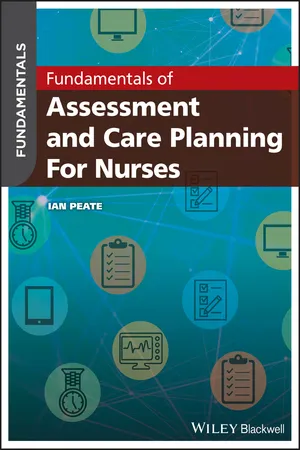
- English
- ePUB (mobile friendly)
- Available on iOS & Android
Fundamentals of Assessment and Care Planning for Nurses
About This Book
All nursing students are required to meet the seven standards produced by the Nursing & Midwifery Council (NMC) before being entered onto the professional register. Fundamentals of Assessment and Care Planning for Nurses addresses two of these important standards, helping readers become proficient in assessing patient needs, and planning, providing and evaluating care.
This timely publication adopts a practical approach with NMC proficiencies at its core, providing guidance and insight into the application of key skills and demonstrating competency in real-life settings.
- Centres around a fictitious nuclear family to provide a practical basis to the various chapters and assessment
- Offers mnemonics to enable comprehensive history taking and systematic physical assessment
- Helps readers address socio-cultural considerations they may face in practice
- Includes links to literature that provides further support and additional information
Fundamentals of Assessment and Care Planning for Nurses is an important resource for pre-registration nursing students and Nursing Associates who are required to demonstrate proficiency in the new NMC standards, and other registered practitioners seeking to update their knowledge.
Frequently asked questions
Information
Chapter 1
The nature of nursing
Aim
Learning outcomes
- Provide a timeline outlining key points in the development of contemporary nursing practice
- Identify how care provision over the years has impacted on contemporary practice
- Discuss how the NHS was formed and its current role in the provision of health and social care
- Consider local, national, and international care perspectives
Introduction
- Nutrition is an important part of nursing care.
- Fresh, clean air is beneficial to the sick.
- Sick people require occupational and recreational therapy.
- Nurses should help identify and meet patients’ personal needs and these include the provision of emotional support.
- Nursing should be directed towards two conditions: health and illness.
- Nursing is separate and distinct from the practice of medicine and as such should be taught by nurses.
- Nurses need continuing education.
Review
The National Health Service
Table of contents
- Cover
- Table of Contents
- Preface
- Acknowledgements
- Meet the family
- Chapter 1: The nature of nursing
- Chapter 2: The provision of care
- Chapter 3: Critical thinking and clinical decision making
- Chapter 4: The nursing process
- Chapter 5: Care plans
- Chapter 6: Models of nursing
- Chapter 7: The skills of assessment and planning care
- Chapter 8: Assessment tools
- Chapter 9: Assessing the musculoskeletal system
- Chapter 10: Assessing the circulatory system
- Chapter 11: Assessing the cardiac system
- Chapter 12: Assessing the gastrointestinal system
- Chapter 13: Assessing the renal system
- Chapter 14: Assessing the respiratory system
- Chapter 15: Assessing the male reproductive system
- Chapter 16: Assessing the female reproductive system
- Chapter 17: Assessing the nervoussystem
- Chapter 18: Assessing the endocrine system
- Chapter 19: Assessing the immune system
- Chapter 20: Assessing the skin
- Index
- End User License Agreement